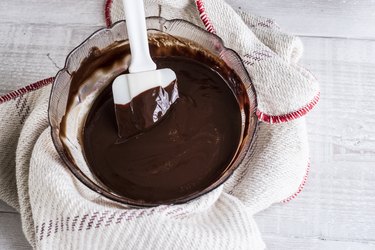
One bite is all you need to taste the difference between baking chocolate and eating chocolate (i.e., milk, dark or white). While each has its uses in the kitchen, they contain different ingredients that make their texture and taste unique from one another.
Tip
Baking chocolate is made up of pure chocolate mass, while milk chocolate contains additives like sugar and milk.
Video of the Day
Understanding the Ingredients
The Confectionary Foundation reports that when cocoa beans are shelled and ground up, a basic substance called chocolate liquor (or chocolate mass) is formed. Chocolate that consists entirely of this mass is called baking chocolate.
Video of the Day
Slightly more than 50 percent of the mass is made up of fat from the cocoa bean. This is called cocoa butter. Baking chocolate is typically hard and snaps or breaks easily. Since it contains no sugar, it usually has a very bitter taste.
Eating chocolate has a different makeup. According to the Harvard T.H. Chan School of Public Health, milk chocolate contains anywhere between 10 and 50 percent of chocolate mass. The rest consists of refined sugar, whole milk or dairy products and cocoa butter. As a result, milk chocolate is much softer and tastes sweet instead of bitter.
Read more: The 10 Best Organic Chocolate Bars
Additionally, there is a wide selection of dark or bittersweet chocolate varieties that span the difference between cooking chocolate and eating chocolate. The percentage of cocoa mass is typically listed on the label. As this percentage gets higher, the amount of sugar decreases and the taste gets bitter.
Watch Your Health
Recently, there have been many claims about the supposed health benefits of chocolate, although Mayo Clinic notes that some of them require further investigation. Many of these assertions center around flavonoids, especially flavonols.
As reported by the Cleveland Clinic, flavonoids are naturally occurring antioxidants that may help your body resist harmful toxins from the environment and repair the damage to its cells. These bioactive compounds may also improve vascular health by increasing blood flow to the heart and brain while lowering blood pressure.
Not all chocolate is created equal, though. In general, as it becomes more processed and ingredients like sugar are added, the amount of flavonols decreases. As a result, baking chocolate and bittersweet chocolate may be healthier choices than milk chocolate.
It is also important to keep the nutritional value of chocolate in mind. One ounce of dark chocolate contains 170 calories and makes up nearly 20 percent of your daily intake of fat and 14 percent of the maximum daily recommended amount of sugar.
Milk chocolate, on the other hand, contains about 152 calories per ounce and provides 13 percent of the daily recommended fat intake and 29 percent of the maximum daily recommended amount of sugar. In general, eating chocolate in moderation or choosing less processed chocolate varieties is the key to being healthier while snacking on something sweet.
Jump-Start Your Baking
Regardless of the difference between cooking chocolate and eating chocolate, both varieties are suitable for homemade desserts. Our Pulse Chocolate-Chip Cookies, for example, require adding semi-sweet or bittersweet chocolate chips to cookie dough. If you're looking for a slightly healthier recipe that still satisfies your sweet tooth, try this LIVESTRONG.com recipe for Gluten-Free Blondies that use a can of chickpeas to lighten up the dessert.
If you prefer cooking with bittersweet chocolate, our Chocolate Crispy Rice Bars use whole-wheat crisped rice cereal and dark chocolate to create a decadent midday snack. You can also get unsweetened cocoa powder, which is essentially powdered baking chocolate with the cocoa butter extracted. This can be used to create a rich and satisfying chocolate mousse.
Don't be afraid to use your imagination. Throw a few bittersweet chocolate chips into some whole-wheat pancakes or top a bowl of Greek yogurt with milk chocolate chips. The possibilities are practically endless and always delicious.